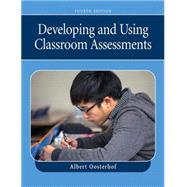
| Introduction | |
| Significance of Measurement | |
| Distinction Between Measurement, Assessment, and Evaluation | |
| Settings Where Assessments Show Up | |
| Distinction Between Formal and Informal Assessments | |
| Roles of Assessment in the Classroom | |
| Maximum Versus Typical Performance | |
| Summary | |
| Key terms: Part 1 - How to Establish a Framework for Assessing Your Students | |
| How Assessments Are Interpreted and Used | |
| Frames of Reference for Interpreting Performance | |
| Meaning of Criterion and Norm-Referenced Interpretations | |
| Choosing the Appropriate Interpretation | |
| Summary | |
| Key Terms | |
| Answers: Apply What You are Learning | |
| Something to Try | |
| Additional Reading | |
| Measurable Objectives and Goals | |
| Categories of Learning Outcomes | |
| Levels of Cognitive Complexity | |
| Instructional Goals Versus Performance Objectives | |
| Selecting Performances that Align with Standards | |
| Summary | |
| Key Terms | |
| Answers: Apply What You are Learning | |
| Something to Try | |
| Additional Reading | |
| Gathering Evidence of Validity | |
| Levels of Cognitive Complexity | |
| Components of Performance Objectives | |
| Instructional Goals Versus Performance Objecti | |
| Table of Contents provided by Publisher. All Rights Reserved. |
The New copy of this book will include any supplemental materials advertised. Please check the title of the book to determine if it should include any access cards, study guides, lab manuals, CDs, etc.
The Used, Rental and eBook copies of this book are not guaranteed to include any supplemental materials. Typically, only the book itself is included. This is true even if the title states it includes any access cards, study guides, lab manuals, CDs, etc.